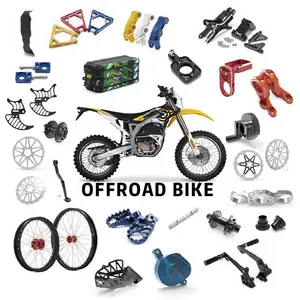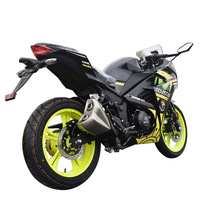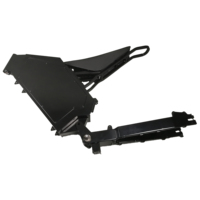
Wholesale All Dirt Bike Parts Off-Road Motorcycle Parts Dirt Bike Accessories With Cheap Price Motorcycle Spare Parts

CNC Motorcycle Parts Painted And Machined With Aluminum Stainless Steel Brass Micro Machining Not Applied






















The heart of a motorcycle's performance lies not just in its engine, but in the very skeleton it's built upon: the frame. A motorcycle frame does more than just hold the components together; it's a pivotal factor in the bike's speed, strength, and overall riding dynamics. This article delves into the transformative power of quality motorcycle frames, exploring how advancements in materials and design have revolutionized the riding experience. From the sleek resilience of various coatings to the innovative offerings on Alibaba.com, and the cutting-edge materials used in high-performance bikes, we'll navigate through the intricate world of motorcycle frames and their substantial impact on performance.

The discourse among motorcycle enthusiasts highlights the significance of frame durability and finish. One user's contemplation of using a thin, wear-resistant coating for a frame rebuild, sparks a debate on the best methods for frame finishing. While this coating is praised for its sleek appearance and durability, some argue that traditional powder coating surpasses it in terms of resilience. An expert who applies this wear-resistant coating regularly admits it doesn't match powder coating's robustness, especially for larger parts like frames, but notes its suitability for smaller components and high-temperature applications. Another user's experience with the coating on a gun carried in a holster resulted in a less than satisfactory finish after short-term use, suggesting that while the coating has its place, powder coating might be the superior choice for a frame that needs to withstand regular wear and tear. This conversation underscores the importance of selecting a quality finish for motorcycle frames, as it directly impacts the longevity and appearance of the bike, especially when it serves as both a functional machine and a showpiece.

Alibaba.com showcases a diverse range of motorcycle frames, catering to various preferences and requirements. Among the offerings, you can find frames designed for high-speed electric motorcycles, which are built to support speeds of up to 100KM/h with power ratings from 3000W to 5000W. These frames are engineered for racing and adult usage, emphasizing performance and durability. Custom frames are also available, tailored for specific models, ensuring a perfect fit and personalized style.
For those looking to modify their motorcycles, there are options such as rear wheel support frames and paddock stands, which are essential for maintenance and customization. The platform also provides frames that come with plastic parts for high-speed scooters, combining strength with lightweight materials. For off-road enthusiasts, metal chassis main body frames for UTVs and ATVs, as well as roll cages, are offered to enhance the vehicle's durability and safety.
In addition to traditional frames, there are innovative solutions like the electric motorcycle frame kits for bike conversions, which cater to the growing trend of electric mobility. These kits include suspension systems for mountain ebikes, allowing for a seamless transition from traditional to electric. For utility purposes, sturdy cargo tricycle frames are available, designed to handle the demands of carrying heavy loads.
Lastly, the selection includes specialized frames such as Carbon Fiber Frame Covers, which offer a blend of high strength and low weight, and CNC aluminum frames with anti-drop sliders, providing both protection and customization opportunities. Whether for upgrading performance or enhancing aesthetics, Alibaba.com's range of motorcycle frames meets the needs of different riders and applications.
Motorcycle frames are the backbone of the bike, providing structural support and influencing the vehicle's overall performance. Initially, frames were predominantly made from tubular steel, a material known for its durability and strength. However, the evolution of motorcycle design has introduced a variety of materials that cater to different performance requirements. Modern frames often utilize materials such as aluminum, titanium, magnesium, and carbon fiber, each offering unique benefits. Aluminum frames are noted for their balance between strength and lightness, often constructed in angular forms for a rigid monocoque design. Carbon fiber stands out for its exceptional strength-to-weight ratio, a characteristic that has been leveraged in competitive racing motorcycles for improved agility. Magnesium and titanium are also prized in high-performance frames for their lightweight properties and high tensile strength, contributing to a motorcycle's speed and handling capabilities. The choice of material is a critical decision for designers, as it directly impacts cost, complexity, weight distribution, and the overall stiffness of the motorcycle, all of which are pivotal to the bike's handling and speed.
The design of a motorcycle frame plays a pivotal role in determining the bike's speed and strength. Frames serve as the backbone of the motorcycle, supporting the engine and providing the structural integrity necessary for handling both the rider's weight and dynamic forces during riding. Different frame designs offer varying levels of rigidity, weight distribution, and aerodynamics, all of which significantly impact performance. For instance, the perimeter frame, also known as the beam or twin spar, wraps around the engine and connects the steering head and swingarm pivot closely, enhancing rigidity for better handling at high speeds. Trellis frames, constructed from metal tubes arranged in a triangulated pattern, offer a balance of strength and lightness, contributing to a motorcycle's agility. The materials used, such as aluminium, carbon fibre, and titanium, also affect the frame's weight and stiffness, further influencing the motorcycle's speed and strength. Advanced materials like carbon fibre are noted for their high stiffness-to-weight ratio, offering superior handling and acceleration. Ultimately, the frame's design and material composition are crucial in crafting a motorcycle's performance characteristics.

The evolution of motorcycle frame manufacturing has been significantly influenced by advancements in technology. The pioneering use of carbon fiber in the early 1980s marked the beginning of a new era in frame design, leveraging materials previously reserved for the aerospace and Formula One industries. This innovation set the stage for the development of frames that are not only lighter but also offer increased rigidity, enhancing the motorcycle's agility and performance on the racetrack.
Technological progress has also been evident in the adoption of aluminum for frame construction. The move towards aluminum monocoque frames represents a shift to integrating the latest in material science and engineering design. These frames utilize a combination of castings and sheet-metal stampings to create a backbone that provides superior strength while minimizing weight.
Moreover, the manufacturing processes themselves have evolved. The use of precision welding and brazing in trellis frames, for instance, exemplifies the application of intricate metalworking techniques to achieve a balance between lightweight construction and structural integrity. The result is a frame that directly connects the steering head to the swingarm pivot in the most efficient way possible, using metal tubes arranged in a triangulated pattern for reinforcement.
When selecting a motorcycle frame for your custom chopper, it's crucial to consider certain features that will ensure both the aesthetic appeal and functionality of your bike. The 'stretch' of the frame, which includes the amount of stretch in the downtubes and the backbone, is a key characteristic that defines the bike's profile and can affect handling. Frames designed for larger tires need to be robust to support the weight and power of the engine.
The type of frame is also significant. Rolling chassis frames, which come with front and rear wheel assemblies, vary in terms of rigidity and suspension. Rigid frames, often without rear suspension, offer a classic look but may alter the ride quality. On the other hand, frames designed for racing or off-road use prioritize durability and suspension to handle rugged terrains.
Weight is another feature to deliberate. A heavier frame typically provides a smoother ride, but for activities like drag racing, a lighter frame might be preferable for better speed. Ultimately, the frame is the backbone of your chopper, and selecting one involves careful consideration of these features to ensure it meets your specific needs and preferences for performance and style.
Upgrading to a quality frame offers significant advantages for motorcycle enthusiasts seeking enhanced performance. A well-designed frame, characterized by its geometric shape when viewed from the side, contributes to a well-balanced chassis. The straight lines connecting the head pipe to the rear swingarm pivot are engineered to maximize torsional rigidity. This rigidity is crucial as it influences the motorcycle's responsiveness and stability during rides. The structure, with its box-shaped cross-section, ensures that the engine is mounted with substantial rigidity, leading to improved handling. The balance of forces between the front wheel and the rear drive force is a key factor in the superior performance of motorcycles equipped with this frame. By focusing on the balance of these forces, the frame aids in delivering a ride that is both responsive and stable, characteristics that are essential for high-speed maneuvering and precision. The design, which has been refined over years of development, is rooted in the principles of achieving optimal performance through a harmonious force balance within the frame's structure.
The application of quality frames is pivotal across various motorcycle categories, influencing performance, durability, and rider safety. In racing motorcycles, monocoque frames, which distribute loads across their external skin, offer enhanced rigidity and agility, contributing to superior handling and speed on the track. This design principle combines the benefits of traditional and monocoque frames to deliver improved performance.
For street motorcycles, the variety of frame types from spine or backbone to full duplex cradle designs cater to different needs. The spine frame, supporting the engine from a single spine, offers a simple and solid structure, while the full duplex cradle design, with its pair of separate cradles, provides a classic example of strength and durability. The perimeter or twin spar frame, often made from pressed metal, wraps around the engine to connect the steering head and swingarm, optimizing for rigidity and compactness, which is crucial for high-speed stability and cornering precision.
Trellis frames, utilizing triangulated metal tubes, offer a balance between weight and strength, making them a popular choice for both racing and production motorcycles. The technology behind these frames, including the use of advanced materials like carbon fiber and aluminum, has trickled down from the racing world to consumer motorcycles, allowing everyday riders to benefit from the same technology that powers Grand Prix winners. This cross-pollination of technology underscores the importance of frame design in motorcycle performance across all categories.
In conclusion, the journey through the world of motorcycle frames reveals their profound influence on a bike's performance. Quality frames contribute not only to the longevity and aesthetic appeal of motorcycles but also to their speed, strength, and handling. The evolution of frame materials and designs, from the use of durable steel to the adoption of lightweight aluminum and carbon fiber, has led to significant advancements in motorcycle technology. The design intricacies of frames like the well-engineered geometric frame highlight the importance of structural rigidity for responsive and stable riding. Moreover, the application of these frames across different motorcycle categories, from racing to street bikes, demonstrates their versatility and the critical role they play in enhancing rider experience and safety. Whether for a custom chopper or a high-speed racer, selecting the right frame is a testament to the rider's quest for excellence on the road. The discourse on frame quality, materials, and design culminates in a singular truth: the frame is the foundation upon which the essence of motorcycling is built.